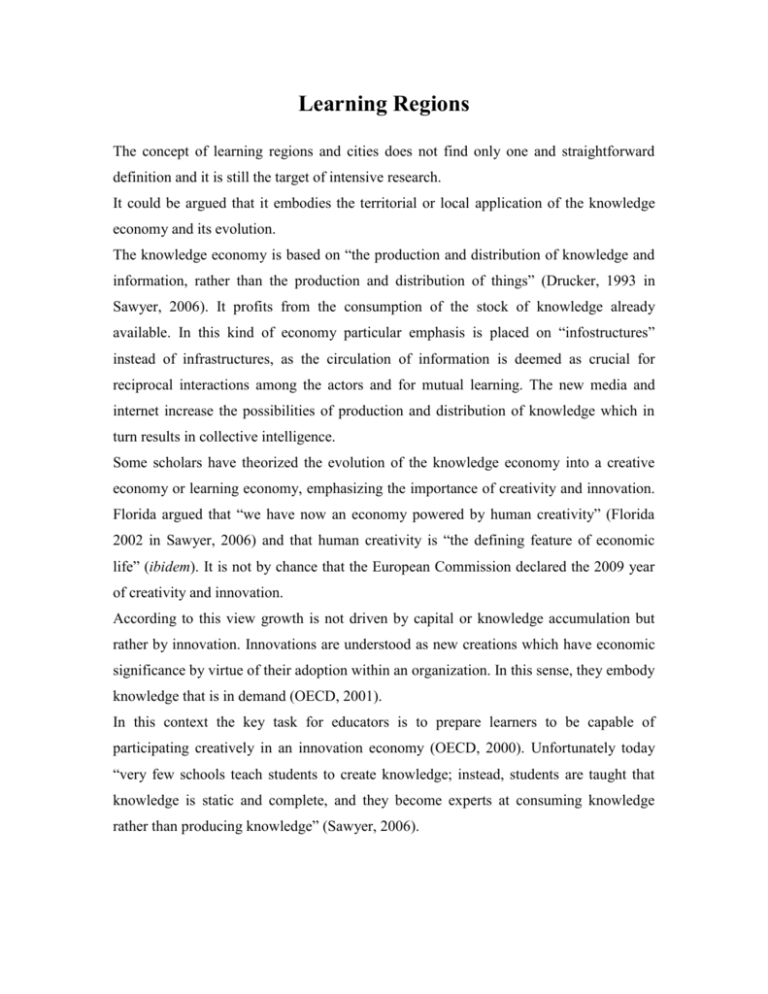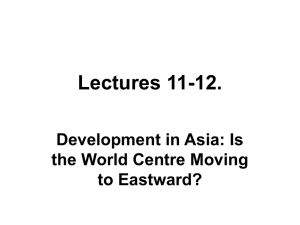Learning Regions
advertisement

Learning Regions The concept of learning regions and cities does not find only one and straightforward definition and it is still the target of intensive research. It could be argued that it embodies the territorial or local application of the knowledge economy and its evolution. The knowledge economy is based on “the production and distribution of knowledge and information, rather than the production and distribution of things” (Drucker, 1993 in Sawyer, 2006). It profits from the consumption of the stock of knowledge already available. In this kind of economy particular emphasis is placed on “infostructures” instead of infrastructures, as the circulation of information is deemed as crucial for reciprocal interactions among the actors and for mutual learning. The new media and internet increase the possibilities of production and distribution of knowledge which in turn results in collective intelligence. Some scholars have theorized the evolution of the knowledge economy into a creative economy or learning economy, emphasizing the importance of creativity and innovation. Florida argued that “we have now an economy powered by human creativity” (Florida 2002 in Sawyer, 2006) and that human creativity is “the defining feature of economic life” (ibidem). It is not by chance that the European Commission declared the 2009 year of creativity and innovation. According to this view growth is not driven by capital or knowledge accumulation but rather by innovation. Innovations are understood as new creations which have economic significance by virtue of their adoption within an organization. In this sense, they embody knowledge that is in demand (OECD, 2001). In this context the key task for educators is to prepare learners to be capable of participating creatively in an innovation economy (OECD, 2000). Unfortunately today “very few schools teach students to create knowledge; instead, students are taught that knowledge is static and complete, and they become experts at consuming knowledge rather than producing knowledge” (Sawyer, 2006). Public institutions should therefore promote the circulation of information, the integration among the various private actors and they should provide incentives to a cooperative behavior of private actors. The very concept of creativity is indeed deeply social: “the most important creative insights typically emerge from collaborative teams and creative circles” (Farrell, 2001 in Sawyer, 2006) and “empirical studies show that even single firms rarely innovate alone” (OECD, 2000). Since the “creativity and innovation” model implies a cooperative approach including different actors, it can be more easily achieved at the local level. Indeed creativity emerges from the decentralization of decision making, as actors to be involved in innovation should share common aims, mental models, trust and loyalty (Cappellin, 2006). The process of knowledge creation also presents “considerable spill-over effects which results in secondary benefits of proximity to the source of knowledge production, such as the development of high technology clusters, the attraction and retention of skilled workers, the attraction of investment, and the spinning off of new firms, jobs, and industries” (ibidem). As the process of interaction among the actors is so important, the concept of sectoral/geographical clusters deserves special attention. They are the conceptualization of the network that facilitates transactions, cooperation and learning in an uncertain world. They are learning organizations, a non-market device by which firms seek to coordinate their activities with other firms and other knowledge institutions. They build trust and work to limit the damaging consequences of asymmetric information (ibidem) . In a globalized world of freely moving capital and increasingly freely moving people, only “social capital” remains tied to specific locations. In fact, the “learning economy” is characterized by the hypermobility of the information and knowledge and the local character of the social capital (Cappellin, 2006). According to the OECD (2001) the learning region “constitutes a model towards which actual regions need to progress in order to respond most effectively to the challenges posed by the ongoing transition to a “learning economy”. Grabher (1993) tries to explain the learning regions as a response to political lock-ins: they can be considered as thick institutional tissues aimed at preserving existing industrial structures and therefore unnecessarily slowing down industrial restructuring and indirectly hampering the development of indigenous potential and creativity. The learning region concept seems to be focused on overcoming and avoiding political lockins in old industrial areas. Such thick institutional tissues are made of political administrations, trade unions, large enterprises and business support agencies: they form a so-called self-sustaining coalition. In this kind of networks status is privileged over knowledge, power over learning and past over present. In other words, these networks lack the capacity to positively responding to changes from outside and “un-learn”, that is to say to avoid path-dependent development. Learning regions are characterized as a bottom-up concept, involving transparent, faceto-face relations, integrated solving of problems (crossing of policy fields) and permanent organizational learning with feedback effects. This network “is open to learning, both to intra-regional and inter-regional level, and willing to un-learn” (Hassink, 2004). The distinction between “good” and “bad” agglomerations should point to the ability to “un-learn”, “which involves the removal of formerly significant institutions which now act as a hindrance to further development. There appears a great variation in the ability of regions to “un-learn”, which makes it possible in some regions but not in others to inaugurate new institutions and simultaneously dissolve ones” (Maskell & Malmerg, 1999 in Hassink 2004). What really makes the difference is the role of the institutions in the process of innovation: development processes do not take place in a vacuum but rather have profound institutional and cultural roots (North, 1981, 1986 and 1990 in Cappellin, 2006). Political and economic institutions should fulfill the task of creating an economic environment that induces increasing productivity (North, 1991 in Cappellin, 2006). Economic development, than, is stimulated in those territories with highly evolved, complex and flexible institutional systems. That is why training and research institutions, entrepreneurial associations, unions and local governments can more efficiently use available resources and improve competitiveness when firms are integrated into territories characterized by thick relational networks. Barriers, which hinder self-sustained growth processes, frequently appear due to deficiencies in and poor performance of the institutional network (Cappellin, 2006). Scope for action In 2006 an expert group issued a report called “Constructing Regional Advantage” on behalf of the European Commission DG RTD-M. Building on the theory of constructed advantage1, considered being the next evolutionary step in regional economic development, they advocate for more attention to the role and impact of the public sector in the economy and they stress the importance of economic complementarities in knowledge economies. Instead of market failure, the rationale for policy intervention is the reduction of interaction or connectivity deficits. A regional innovation systems approach, which is the key to constructed advantage, sees such deficits as the core problem of innovation in the EU (expert group, 2006). It is therefore important to make sure that firms take up the challenge: indeed, evidence suggests that firms rarely co-operate with neighboring firms on their own initiative. In this regard, I believe NGO’s have an important role to play: as sometimes local governments can be part of those self-sustaining coalitions which hamper industrial change and, thus, growth, NGO’s can act as useful players in building new networks of firms and social actors with the aim of braking political lock-ins. NGO’s can have a role also in the “unpacking strategy” advocated in the expert group report. The strategy is based on: Related variety; Differentiated knowledge bases; Distributed knowledge networks; Trans-sectoral platform policies. Related Variety combines the strength of the specialization of “localization” economies and the diversity of “urbanization” economies. It means that “knowledge will spill-over effectively between sectors when complementarities exist among sectors in terms of shared competences” (Boschma & Iammarino, 2007). It allows higher absorptive capacity and more rapid diffusion of innovations among related-producer communities. Here EVTA might have a role to play in the identification of shared competencies between firms. This information should be useful in order to effectively choose the actors which should take part to the network. Constructed advantage: firms apply an open innovation model and thus, rely on sourcing – sometimes globally – for the best talents. Simultaneously, they seek outsourcing or off-shoring of standardized labourintensive activities to low-cost countries. 1 Differentiated knowledge bases refers to “different mixes of tacit and codified knowledge, codification possibilities and limits, qualifications and skills required by organizations and institutions involved, as well as specific innovation challenges and pressures. Crossing such boundaries is the hearth of the connectivity problem” (expert group, 2006). In this regard EVTA could also play an important role, especially in the identification of qualifications and skills required by the organizations and institutions involved, as well as the codification of tacit knowledge. Distributed knowledge networks which take into account a globalisation perspective for using distributed and data and knowledge sources. In this regard it could be argued that EVTA is in itself a distributed knowledge network, as it is capable of drawing on several sources of knowledge in as many countries as the number of its partners. Trans-sectorial platform oriented policies as a support for related variety. As a result of the very fast pace of the technological change, innovations are often in general purpose technologies with applications over a range of services, products and industries. The expert group report is very clear when as a guideline and an advice to “carriers” of policies it advocates for: A reorientation in the target level of support, changing innovation policies from being firmoriented to a (regional) system-oriented perspective; A change in the focus from allocation of resources for innovation to focusing on innovative learning, aiming for behavioral value-added through pursuing a platform-oriented perspective; A focus on the role of knowledge creation, absorption and diffusion generally, with R&D and Symbolic Creativity more specifically in a well-structured and well-organized interplay of local and global knowledge flows (expert group, 2006). REFERENCIES Ron Boschma & Simona Iammarino, Related Variety, Trade Variety and Regional Growth in Italy, Utrecht University, 2008 Riccardo Cappellin, Regional Governance in the Knowledge Economy: policy strategies and policy-making models, Eurodite Project (FP 6, priority 7) Regional Trajectories to the Knowledge Economy: a Dynamic Model, 03-2006 Expert group, Constructing Regional Advantage, report prepared by an independent expert group for the DG Research of the European Commission, 2006 Henrik Halkier, Regional Policy and Knowledge Processes: Towards a Framework for Analysis, Eurodite Project (FP 6, priority 7), Regional Trajectories to the Knowledge Economy: a Dynamic Model, 09-2005 Robert Hassink, The Learning Region: A Policy Concept to Unlock Regional Economies from Path Dependency?, Paper prepared for the conference Regionalization of Innovation Policy – Options and Experiences, June 4th – 5th 2004 Berlin OECD, Cities and Regions in the New Learning Economy, 2001, Paris R. Keith Sawyer, Educating for Innovation, Department of Education Washington University in St. Louis, 19 January 2006








